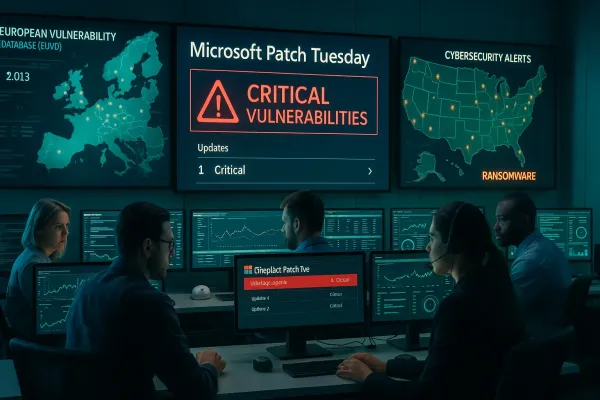
Microsoft Patch Tuesday- Key Vulnerabilities & Responses
As organizations transition to increasingly cloud-based infrastructures and digital workflows, the urgency to maintain robust cybersecurity practices escalates. The latest Patch Tuesday release from Microsoft highlights this pressing need, as the tech giant addressed 75 security vulnerabilities in its May update, including 11 classified as critical. This surge in vulnerabilities draws attention to the prevalent risks posed by inadequately patched systems, particularly as cybercriminals continuously evolve their tactics.
In this blog entry, we will delve into the critical vulnerabilities identified in Microsoft’s May Patch Tuesday, insights on recent cybersecurity developments, and strategic recommendations for incident responders and IT security professionals.
Overview of the May Patch Tuesday Update
Key Vulnerabilities
Among the patches issued in May, several are of particular concern due to their exploitability in real-world scenarios:
-
Critical Vulnerabilities:
- CVE-2025-32702: Vulnerability in Visual Studio allowing remote code execution through local exploitation.
- CVE-2025-30397: Memory corruption vulnerability in the Windows Scripting Engine enabling code execution.
- CVE-2025-32701 and CVE-2025-32706: Elevation of privilege (EoP) vulnerabilities in the Windows Common Log File System driver.
-
Emerging Risks:
- CVE-2025-4427 and CVE-2025-4428: Two significant vulnerabilities in Ivanti Endpoint Manager Mobile (EPMM) posing a risk of unauthenticated remote code execution when exploited in a chained manner.
Exploitation Status
Reports indicate that five of the identified vulnerabilities are actively being exploited in the wild. Not only does this call for immediate action from security teams to deploy patches, but it also highlights a disturbing trend of rapidly exploitable gaps in widely-used enterprise software.
Analysis and Insights on Microsoft Vulnerabilities
Active Exploitation and Ransomware Implications
As the cybersecurity landscape evolves, vulnerabilities related to privilege escalation and remote code execution are becoming the primary attack vectors for many ransomware groups. The average time between disclosure and exploitation is now believed to be less than five days according to experts. This fact underscores the urgent need for organizations to prioritize timely application of security patches.
Eminent Trends
Dustin Childs from the Trend Zero Day Initiative hints at an uptick in Office-related vulnerabilities, indicating potential for upcoming targeted attacks. With the Pwn2Own competition expected soon, which has a history of leading to the publication of zero-day exploits, network defenders must remain vigilant and proactive in patching critical systems.
The Launch of the European Vulnerability Database (EUVD)
In a strategic move towards enhancing cybersecurity resilience across Europe, the European Union Agency for Cybersecurity (ENISA) has launched the European Vulnerability Database (EUVD). This initiative is part of the European Union’s NIS2 directive aimed at providing a centralized repository for vulnerabilities while addressing recent turmoil concerning the CVE (Common Vulnerabilities and Exposures) program in the U.S.
Goals and Features of the EUVD
- Aggregation of Vulnerability Data: EUVD aggregates data from multiple sources, including MITRE’s CVE, industry vendors, and CSIRTs to streamline vulnerability management.
- Three Dashboard Overview: It offers dashboards specifically focused on critical vulnerabilities, exploited vulnerabilities, and coordinated disclosures by EU CSIRTs. This improves visibility for cybersecurity professionals attempting to manage vulnerabilities across diverse platforms.
Implications for Cybersecurity Professionals
With the emergence of the EUVD, organizations must adapt their vulnerability management strategies to include not only the existing U.S. databases but also European sources. This necessitates a review of tools used for monitoring vulnerabilities to ensure comprehensive coverage spanning both U.S. and EU databases.
Conclusion
The insights gained from the recent Microsoft Patch Tuesday, combined with the strategic deployment of the European Vulnerability Database, stress the importance of robust patch management and vulnerability monitoring in an age of evolving cyber threats. Security professionals must adopt a holistic approach that recognizes vulnerabilities across multiple platforms while prioritizing timely updates.
Moving Forward
For CISOs and security teams, these developments reinforce the criticality of not only implementing the latest best practices in vulnerability management, but also fostering a proactive culture of cybersecurity. Continuous education, integrating emerging databases, and vigilant monitoring of threat landscapes will be crucial in defending against the increasing sophistication of cyber threats.
Call to Action
- Expedite Patch Deployments: Organizations should implement a policy for quick deployment of security patches, especially those flagged as critical.
- Monitor Vulnerability Sources: Ensure that systems are in place to monitor not only the CVE but also the newly launched EUVD and related frameworks.
- Promote Cyber Hygiene: Foster a culture of security within organizations, encouraging employees to follow best practices to mitigate human-error related vulnerabilities, often exploited through phishing techniques.
Staying informed and actively managing vulnerabilities is not just a defensive strategy—it’s a necessary commitment to organizational security in an unpredictable digital landscape.